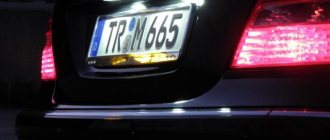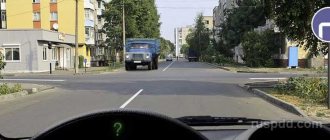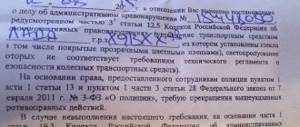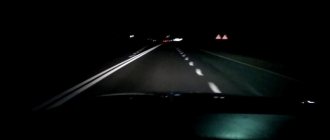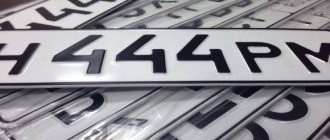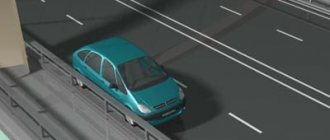Regulatory aspects
The Regulations of the Road Traffic Regulations state that every car must be equipped with special lighting equipment for the rear of the car, capable of being switched on when the side lights are operating. Accordingly, it must be activated in the dark so that the traffic police inspector can easily distinguish the symbols of the vehicle’s “mini-passport” from a distance of at least 20 meters.
The fine for the lack of illumination of the rear license plate and, accordingly, its unreadability is 500 rubles.
The possibility of losing your driver's license for a period of 6-12 months with confiscation of the lighting device is also present. The owner of a vehicle may be subject to such punishment for illuminating the front registration plate, since according to regulatory documents it must be absent.
The essence of the violation
If the recorded violation of the motorist is associated solely with the lack of illumination as such, the amount of the fine will be the most significant, since in this situation there is a fact of a conscious violation of the current traffic rules.
Moreover, such a violation can be regarded as a deliberate obstacle to the performance of official duties by law enforcement officers.
If there are no lamps, the fine imposed on the driver will be 500 rubles.
In a situation where the lack of lighting is due to a breakdown of the lighting device, such a moment is also regarded as a violation. This is due to the fact that the driver has an obligation before driving the vehicle to check its serviceability and eliminate any problems.
Sometimes a violation in which only one of the two lamps illuminating the state license plate is faulty, and the light of the second is sufficient, prosecution can be challenged.
This is due to the fact that, in fact, the accrual of a fine according to the current DD rules is not associated specifically with the breakdown of the backlight. This penalty is imposed for violating the norm - the license plate of the vehicle must be located in such a way and equipped with such additional means that allow it to be identified from a distance of 20 meters. In certain situations, such an indicator can be challenged on both sides - both by the traffic inspector and the driver, but, as practice shows, the lack of illumination rarely becomes the cause of a conflict - it is easier to agree with the malfunction and receive a warning than to challenge the drawing up of a protocol and receive a fine.
Grounds for punishment
The readability of a registration number means the ability of a traffic police officer to see and easily understand what is indicated on them from a distance of 20 meters. Lack of lighting, improper lighting, a light bulb that does not work or has burned out do not provide this opportunity.
Factors that may cause a fine:
- lighting, the color of which does not comply with traffic regulations;
- The number plate light does not light up;
- non-working light bulb.
The reason for the fine may be lighting, the color of which does not comply with traffic regulations.
When a violation is detected by a traffic police inspector, in such a situation, even if the owner of the car corrects the problems, he will have to pay a fine, which is specified in the Code of Administrative Violations.
If you were stopped for the first time on the basis of non-compliance with the above rules, you can use one “saving” nuance - say that before leaving everything worked properly, and the inspector himself informed you about the problem. You will be given a verbal warning and given 24 hours to replace the faulty LEDs.
What kind of lighting should it be?
The illumination of the front number plate does not matter, but if car enthusiasts want to illuminate it, then they can only install white or yellowish lamps.
Otherwise, you will face the following penalties provided for by the Code of Administrative Offences:
- the driver can be fined 3,000 rubles;
- lighting equipment will be confiscated;
- a ban on the use of this vehicle is possible;
- For repeated violations, license plates will be removed.
Red lights or reflective devices must not be installed on the front of the vehicle.
Other lighting devices, the color of the lights and the operating mode of which are prohibited in accordance with the requirements of the Basic Regulations for the admission of vehicles to operation and the duties of traffic officials.
For such a violation, the fine amount is not the same as for the lack of rear license plate illumination - the driver will have to pay 3,000 rubles. This applies to individuals.
For officials, the amount of the fine is much higher, it ranges from 15,000 to 20,000 thousand rubles. And for legal entities - 400,000-500,000 rubles, while instruments and accessories are confiscated.
Grounds for punishment
The readability of a registration number means the ability of a traffic police officer to see and easily understand what is indicated on them from a distance of 20 meters. Lack of lighting, improper lighting, a light bulb that does not work or has burned out do not provide this opportunity.
Factors that may cause a fine:
- lighting, the color of which does not comply with traffic regulations;
- The number plate light does not light up;
- non-working light bulb.
The reason for the fine may be lighting, the color of which does not comply with traffic regulations.
When a violation is detected by a traffic police inspector, in such a situation, even if the owner of the car corrects the problems, he will have to pay a fine, which is specified in the Code of Administrative Violations.
If you were stopped for the first time on the basis of non-compliance with the above rules, you can use one “saving” nuance - say that before leaving everything worked properly, and the inspector himself informed you about the problem. You will be given a verbal warning and given 24 hours to replace the faulty LEDs.
What the rules say
The traffic rules state that the owner of the car is obliged to ensure that the state license plate is legible. In this case, rear license plate illumination is required at night - it is not needed in front. White or yellow light must be used for lighting - blue backlighting of the license plate is not allowed.
The license plate illumination must be sufficient to ensure its clearest visibility at night.
The readability of license plates is explained as an opportunity for a traffic police inspector to view them from a distance of 20 meters. It is believed that a broken light bulb or incorrect lighting does not provide this opportunity. The reason for the fine for “unreadability” may be one of the following factors:
- The number plate light does not light up;
- blue number plate illumination;
- use of means to impair the readability of license plates.
If the license plate light on your car does not light up, and you were stopped by the traffic police, you can claim that you left with an illuminated license plate, but a breakdown occurred along the way.
In the case where the license plate illumination does not work, a fine will be issued if the police can prove that you knew about it when leaving the garage.
If you managed to convince the inspector that the breakdown occurred on the road, no fine will be charged for the lack of rear license plate illumination. In this case, you will be given a warning and will be required to fix the problem within 24 hours.
The color of the license plate illumination is either white or pale yellow
How can you avoid a fine or evade it?
The law does not establish any possibility for a driver to avoid a fine other than receiving a verbal warning from an inspector.
At the same time, the traffic rules do not contain a list of reasons that can mitigate the guilt of the car owner and push the road service officer to do without a fine.
In practice, the driver has several opportunities to prove his innocence. If you did not know about the breakdown, then you should definitely inform the inspector about it.
In late autumn and winter, when it gets dark early, the driver can also say that he is aware of the breakdown and is just heading to the service station to have it repaired. According to established practice, in this case, law-abiding traffic police officers do not fine the driver.
Not all cars can replace the license plate light bulbs yourself. If in your car the sign is illuminated not by a simple pair of incandescent lamps, but by a diode strip or other complex structure that can only be replaced by a master, then it will be easier to avoid a fine. You just need to point out to the inspector that it is impossible to correct the situation on your own and ask him to limit himself to a warning.
How to stick
It is not difficult to apply the film yourself, as it is self-adhesive. To fix it on a car sign you need:
- Clean the license plate, degrease with alcohol or acetone.
- Match the numbers from the film and the license plate as accurately as possible.
- Remove the protective backing.
- Smooth out the film. Make sure there are no swelling due to air bubbles.
- Warm up the nanometer with a hairdryer for 2-3 minutes, wait until it cools completely and smooth it thoroughly again (this is an optional step, but exposure to hot air will ensure strong adhesion to the surface of the car sign).
The service life of the license plate sticker is at least 7 years. No special care is required - you can easily wash it without fear that it will peel off from water or detergents.
How to remove
The film is firmly glued to the surface, but it can be removed in a simple way. To do this, you need to warm the surface with a hairdryer, and while it is hot, pry the tip with a sharp object and pull. The remains are cleaned off with a hard rag. You should not try to scrape off the film with a blade or a metal brush; this will damage the paint on the license plate.
Requirements
According to traffic regulations, car registration symbols must be designed according to the standard, correctly installed and readable.
At the same time, the ability to make out what is depicted on the plate must be preserved even in the dark hours of the day. For this purpose, lighting is used, which refers to the external lighting devices of the vehicle. Interestingly, the conditions for additional illumination do not apply to front signs. IMPORTANT! If the rear license plate lighting does not function, the defect is considered a vehicle malfunction. Driving with deviations from the norms, including damage or inoperability of any elements of the car, is considered a violation and is subject to a fine.
In the case of a partial defect, for example, if one of the light bulbs does not light or the device is covered with a layer of dust or dirt, due to which the light does not reach the symbol plate well, a monetary penalty may also be imposed. If the lighting does not work during the daytime, there are no sanctions.
If the backlight is blue
The rules will be violated if external lighting devices do not meet the requirements:
- orange, white, yellow front lights;
- red, orange, yellow lights at the rear of the vehicle;
- White license plate illumination at the rear.
IMPORTANT! Lighting the rear number with blue lights is prohibited. The presence of lights of this color is considered a serious offense. The penalty is deprivation of a driver's license for up to 1 year.
Penalties are also provided for placing lighting fixtures of the following colors:
- green;
- brown;
- violet;
- red light in front;
- white color at the front, excluding registration plate and reversing lights;
- multi-colored lights, except white, for illuminating signs and rear traffic lights.
There is no penalty in this situation, as in the case if the light is blue. The penalty will be the confiscation of the driver's license.
Video about license plate lighting
If there is no illumination of the license plates of the vehicle registration located at the rear, a fine of 500 rubles is provided. Sanctions are also imposed in the event of a partial breakdown, since it is included in the list of vehicle faults that cannot be driven with.
Responsibility for civil protection that is not visible due to the cargo
A car is a means of transportation not only for a person, but also for the things he uses. So, you can transport large cargo in the trunk of a car, and install bicycles on special frames, which you can ride in the forest.
Transporting large cargo with an open trunk without a visible license plate. Photo: uborka.co
When transporting, the HZ can be turned upward or covered by the wheels of a bicycle. The question arises: will the driver be held liable under Art. 12.2 of the Code of Administrative Offenses of the Russian Federation for concealing numbers?
Before the trip, the driver must make sure that the safety zone on his car is not blocked by the cargo being transported. In case of evasion of this provision, he becomes liable under Art. 12.21 Code of Administrative Offenses of the Russian Federation for unacceptable transportation of cargo.
Please note that if the civil license plate was covered with cargo that relates to the car as a whole, then the traffic police inspector does not have the right to hold you accountable for hidden license plates, which was rightly noted by the Supreme Court of the Russian Federation
Is blue backlighting allowed?
To understand what colors are allowed in the backlight of a car’s registration plate, you need to look at the “Basic provisions...”. There is a list of problems with the machine that cannot be used. Features of the state of external devices are also reflected in the document. In particular, it is prohibited to drive a car if it has the following features according to clause 3.1:
In addition, you cannot use a car whose license plate illumination does not comply with GOST 8769. Regarding their color, subclause 2.8.2 of the document says:
This means that any other light bulbs, including blue ones, cannot be screwed in for this purpose. Violation threatens to pay a fine of 500 rubles.
About the intensity of the backlight and the permitted colors of LEDs
According to GOST, the light of rear registration plates must be white or yellow, or shades thereof. Thus, any other color of lighting may be regarded as a violation and subject to a corresponding fine of 3,000 rubles, since colored LEDs can confuse drivers following and provoke a traffic accident.
License plate lighting is not a problem; it can be implemented by upgrading the standard lights
Taking into account the standards, it is possible to change the tonality and saturation of the lighting. However, this must be done without attracting the inspector’s attention by using too bright a light, which leaves a mark on the road surface, as well as using excessive amounts of license plate lighting of other colors.
Is it possible to install blue light bulbs in 2020?
It depends on where you install them. But let us point out right away that this is prohibited if any light fixture outside the vehicle is shining blue. In general, in practice in 2021, any hint of flashing lights of the special services leads to severe tension for traffic police officers, followed by punishment.
Now let's take a closer look, with references to official laws, at individual lighting devices:
- is it possible to use blue or violet lamps in dimensions,
- is this color allowed in low and high beam headlights,
- in fog lights,
- Is it possible to illuminate the rear license plate light in blue?
In dimensions
So, our issue is regulated not only by the Basic Provisions, but also by another legal act - GOST R 51709-2001.
And, if the Rules indicate only that the front color of the headlights should be exclusively white, or orange, or yellow, then the State Standard prescribes narrower boundaries - in particular, for the front dimensions an exclusively white color is provided - the installation of blue bulbs is neither the Rules nor GOST is not allowed.
And, in fact, the proofs:
In near or high beam
It is also prohibited to install blue lamps here. The same paragraph of the Rules implies any lights at the front of the car - this also includes the headlights in any operating mode.
GOST, in turn, prescribes exclusively white color in both low and high beams. That is, everything here is exactly the same as in the case of side lights - blue light bulbs are not allowed.
In PTF
In the case of “foglights” in 2021, the difference is very small:
- The basic provisions prescribe the same white, orange or yellow colors,
- but Gosstandart is white or yellow.
And again, no reference to the possibility of setting the color blue.
You will also be interested in:
- Fine for non-working rear license plate light in questions and answers
- What color headlights are allowed and prohibited according to traffic regulations? Can they be tinted?
- The car does not have fog lights - is it safe to drive? Responsibility
In the backlight of the license plate
And this is the first case when both regulations we are discussing are united in one thing: both GOST and SDA prescribe only white color for illuminating the rear warning light.
The reverse light should have the same color. And for all other lights at the rear, GOST provides exclusively red color:
- for rear dimensions,
- brake signals,
- rear dimensions,
- rear contour lights,
- as well as any reflectors similarly in the rear of the car.
A The basic provisions for the same lighting devices are red, yellow or orange.
Turn signals
Of course, the use of blue lights in turn signals is also prohibited. Everything here is similar to that described above:
- for front direction indicators, according to OP, white, yellow or orange colors are possible, according to GOST - only yellow,
- for the rear ones - red, yellow or orange according to traffic regulations, yellow - according to the standard.
Thus, the answer to the question whether it is possible to install blue light bulbs in any light, according to the 2021 legislation, is sharply negative - this is prohibited for external lighting devices.
Requirements for license plate illumination
Some car owners prefer to modernize lighting devices without taking into account the requirements of GOST-8769-5. It is this legislative act that regulates the features of external lighting units.
What are the requirements for license plate illumination:
- The lamp is installed only on the rear of the car. Installation in the front is optional, but if the driver wants, he can install white or yellow lamps.
- Rear license plate illumination is required. It should only be white. The use of blue, red and other bright colors is not allowed.
If a light bulb burns out, it is recommended to change it immediately. Otherwise, even if one lamp is missing, the inspector may be held liable.
A fine for non-working or missing lighting is issued only if a violation is actually detected by the inspector. There are no devices yet that detect such deficiencies.
What kind of illumination will there be for the wheels and grilles?
Lighting devices located on the front of the car and the wheels are classified as external signals. That is, the presence of extra light bulbs here is a violation and is punishable under Article 12.4 of the Administrative Code:
- for red and any other lighting on the grille and wheels that does not comply with the “Basic Provisions...”, a fine of 3,000 rubles is imposed. for individuals, 15,000 - 20,000 rub. - for officials, 400,000 - 500,000 - for legal entities;
- if installed devices imitate special signals, the fine for citizens will be 5,000 rubles, for officials – 20,000 rubles, for legal entities – 500,000 rubles.
Sequence of work
Of course, you need to start with planning. Decide what color the bottom glow will be. There can be many options: to match the car, white or red, which will shine the brightest in any weather. The installation of underbody lighting also depends on the type: as we wrote above, if between the wheels or only along the front bumper, you will have to make a double connection to the power supply system. The circular illumination, in fact, is looped (connected by soldering and through connectors), in this case one connection to the battery or cigarette lighter is sufficient.
Soldering and connection
Connection in the power supply system is divided into two stages: connecting LEDs to wires, testing and, directly, connecting to the power supply system. The first stage is necessary so that all measurements, soldering, and testing can be done in more comfortable conditions. The second is done after the tape on the profiles is attached to the bottom of the body.
- First stage. This is the most responsible job. It is necessary to cut the tape correctly - in special places intended for connection (usually they are repeated through 3 LEDs). In this case, two mistakes cannot be made: a short strip will be difficult to connect, and a long strip will sag, which is unacceptable, since the backlight will not be continuous and uniform. There is also a high probability of the LED strip breaking at the first bump.
Then we sequentially solder each wire to the LED using a soldering iron.
It is important to strictly monitor the color matching of electrical wiring at the starting and ending points of connection
To ensure that the installation of the underbody lighting is correct and no mistakes are made, it is necessary to conduct a preliminary test. To do this, you need to connect the tape with wires to the power supply system; if the glow is uniform, you can freely continue connecting the remaining parts. And only after that, insulate the soldering with silicate glue. We suggest using a plumbing one, since the machine is usually operated in all weather conditions. And only this type of insulation using a gun guarantees good protection against moisture.
- Second phase. Further connection is made through connectors after attaching the prepared structure to the bottom (therefore, now read the “Attachment” section and only after that return to this subheading). Place a corrugated tube over the wires - this will protect against rupture (it is advisable to fill it with silicone or insulate it for greater reliability).
After connecting all the elements of the lighting system, the wires are connected to the controller (strictly adhering to the diagram). Next step: connecting to the power system. There are several connection options - the easiest is through the cigarette lighter. 12 V is quite enough to provide electricity to the entire system around the perimeter of the bottom. But to do this, you will have to purchase and slightly modify a car charger for a mobile phone, which can lower the voltage to 4 V. In principle, it is simply disassembled and you need to solder one wire in front of the stabilizer, and the second to ground. In this case, it’s quite easy to turn the lighting on and off directly from the car’s interior.
But still, it is considered more correct to connect through fuses to the battery. In this case, the “native” factory wiring of the car is not disturbed and, as a result, problems with the power supply are eliminated.
LED Strip Light
Fastening
Before the next step, be sure to read the “Safety Precautions” section. Thanks to this, illuminating the underbody of the car with your own hands will take place without injury.
Cut the profile to size. We fix the LED with fasteners at a distance of approximately 10–15 cm (this will ensure a tight fit and uniform illumination). We cut off the “tails” of the fasteners.
We fasten the finished structure with self-tapping screws to the bottom (it’s more convenient under the threshold). In this case, there will be more intense illumination. It is more rational to attach LEDs to the rear bumper on a building profile for beacons or arches (it is easier to bend them to the shape of the car). Under the front part of the body we fix it on an L-shaped profile to the bottom.
This type of fastening allows you to hide the source of the glow, makes it uniform, and at the same time the LEDs are protected from impacts during travel. The design is quite durable, since aluminum profiles do not corrode and they are plastic, unlike their metal counterparts.
Underbody lighting - bottom view
Mandatory lighting devices on vehicles
At night and at dusk, visibility deteriorates, so drivers use the lighting available as standard. The machine's lighting equipment consists of the following equipment:
- Low and high beam headlights.
- Running lights for daytime use.
- Fog lights located at the rear and front.
- Parking lights.
- Illuminated rear license plate.
- Parking lights.
- Finders and spotlights.
- Reflectors.
- Side lights.
If some of them are not provided by the basic package, the owner can install them additionally. For example, if the manufacturer did not include light bulbs specifically for state signs in the original design. Installing them at the nearest service station will not cost much. At the same time, this will allow you not to receive a fine for an unlit rear license plate every time, although there will be an opportunity to challenge the protocol.
I was issued a fine for non-functional lighting - how to appeal?
We described in detail the procedure for appealing the decision in a special article on the abolition of the traffic police fine. Your task in this case is to provide sufficient arguments why the issued sanction is illegal.
Examples of such grounds for cancellation are as follows:
- the number was actually legible during daylight hours, but you were given a fine for illumination under Article 12.2 (for this purpose, it is highly advisable to attach a video recording from 20 meters of visibility of the registration mark to the complaint, or to apply for the inclusion of video footage of the inspector, if he made it),
- you went to the place of repair or parking, since you did not have the opportunity to replace the light bulb at the place of stop by an employee, but here the chances of a successful appeal are slightly less, since the courts and traffic police chiefs also understand the possibility of abuse, and you may have to go to higher authorities,
- You can also file a complaint on formal grounds: for missing the statute of limitations for involvement, if the driver is not identified (and the fine is not from the auto-recording camera) and for a number of others - we also provided the full list in.
Below we give, as an example, a sample complaint about a fine for illuminating a license plate in connection with the driver going to the place of repair - the nearest auto shop to buy a lamp and then replace it.
- complaints about a fine for backlighting – DOCX format for filling out on a computer.
- Download a general sample complaint to fill out by hand (PDF format).
Fine for driving with rear license plate illumination not working
If at night a motorist drives his vehicle with faulty rear registration plate lamps, he may be brought to administrative liability under Art. 12.2 Code of Administrative Offenses of the Russian Federation.
Article 12.2. Driving a vehicle in violation of the rules for installing state registration plates on it1. Driving a vehicle with unreadable, non-standard or installed state registration plates in violation of the requirements of the state standard, except for the cases provided for in Part 2 of this article, shall entail a warning or the imposition of an administrative fine in the amount of five hundred rubles. Note. A state registration plate is recognized as non-standard if it does not meet the requirements established in accordance with the legislation on technical regulation, and unreadable if at a distance of 20 meters it is not possible to read at least one of the letters or numbers of the rear state registration plate at night, and in daylight hours of at least one of the letters or numbers of the front or rear state registration plate.
In the context of the article, punishment under this article of the Code of Administrative Offenses of the Russian Federation is imposed in the dark, when the existing illumination of the rear license plate does not ensure its readability from a distance of 20 meters. In this case, it does not matter how and how many license plate lamps are not lit. It is even possible that the car owner has replaced the lamps with non-standard ones, and they both light up, but only illuminate part of the license plate due to their design feature.
In this case, a fine may also be imposed under Art. 12.2, vol.
The number is not readable.
At the same time, sometimes even one remaining working lamp ensures normal readability of the registration plate at night, in this case Article 12.2 cannot be applied. But the above-mentioned Article 12.5 of the Code of Administrative Offenses, which prohibits the operation of vehicles in the presence of a certain list of faults, can be applied.
A motorist can be punished for the absence of the necessary lighting on the vehicle, and for its presence on some parts of the car. Sanctions are regulated by various articles of the Administrative Code. But sometimes it is possible to avoid punishment altogether, while combining the desired appearance of the car and the requirements of the law.
The rear license plate of the car should be visible even at night, for which purpose there is a backlight next to it. It consists of several light bulbs. And the driver needs to ensure that they are all in working order. Penalties due to faulty illumination on the rear license plate may be imposed for two reasons:
- All the light bulbs are burned out and the number is unreadable. This violation is punishable under Article 12.2, part 1:
Driving a vehicle with unreadable, non-standard or installed state registration plates in violation of the requirements of the state standard, except for the cases provided for in Part 2 of this article, shall entail a warning or the imposition of an administrative fine in the amount of five hundred rubles.
- Since illumination of the numbers and letters of the license plate is only necessary in the dark, the traffic police officer has no right to stop the car for this reason during the day and demand a fine from the driver.
- The license plate is illuminated in a color that is not permitted for this area of the vehicle. Only light bulbs emitting white rays are allowed here. All other colors fall under the same article of the Code of Administrative Offenses and will result in a fine of 500 rubles. or a warning.
The absence of illumination of the rear registration symbol will cost the driver of the car without punishment only in one case: if the design features of the vehicle do not require its presence. There are no requirements regarding lighting at night for the number plate attached to the front of the vehicle. It may be indistinguishable at night. Punishment for it is imposed only in cases where on this part of the vehicle:
- Lighting devices not reflected in the technical documents of the vehicle were installed. Part 4 of Article 12.5 applies here, according to which the driver is deprived of his license for 1 - 1.5 years for unauthorized devices.
- Lighting devices of red or other colors are attached that do not comply with the conditions of the “Basic provisions for the approval of vehicles for operation...”. This violation and the punishment for it are reflected in part 3 of the same article. For this, the driver will remain without a driving license for 4 - 6 months.
In both cases, illegal lighting devices are confiscated. So it’s better not to install them on the front number plate of the car at all. We recommend reading about the fine for not turning on the low beams. You will learn about the rules for moving and turning on headlights, fines for not turning on low beams, and for non-working headlights.
And here is more information about fines for special signals.
[custom_ads_shortcode2]
Punishment for backlighting
Deprivation of rights for this offense can be avoided if the lighting does not violate the above rules. But you can still get a fine from a particularly meticulous inspector. It will be impossible to qualify this offense as the installation of improper lighting devices. But you can be punished for making changes to the design of a car without permission to install a light under the bottom of the car.
According to Article 12.5 of the Code of Administrative Offenses, installing uncertified lighting on a car involves a fine of 500 rubles, and if the inspector is loyal, you can get off with a warning. But this is only if only the bottom of the car is illuminated and the bumper, false radiator grille, etc. are not affected.
Despite the fact that there is no ban on illuminating the underbody of a car, you can receive a fine for it even if all installation rules are followed. Therefore, a motorist who has decided on such a procedure should be prepared for increased attention from traffic police inspectors and possible additional costs in the form of paying fines or defending their own rights in court.
Fine for driving with faulty license plate lights
For operating vehicles with faults listed in the above List of Faults, a fine is provided under Art. 12.5 Code of Administrative Offenses of the Russian Federation.
Article 12.5. Code of Administrative Offenses of the Russian Federation: Driving a vehicle in the presence of malfunctions or conditions under which the operation of vehicles is prohibited, or a vehicle on which the identification sign “Disabled” is illegally installed
1. Driving a vehicle in the presence of malfunctions or conditions under which, in accordance with the Basic Provisions for the admission of vehicles to operation and the duties of officials to ensure road safety, operation of the vehicle is prohibited, with the exception of malfunctions and conditions specified in parts 2 - 7 of this article - entails a warning or the imposition of an administrative fine in the amount of five hundred rubles.
This fine is imposed regardless of whether the license plate with non-working backlight is readable or not. Since there is a malfunction of the external lighting devices, operation is prohibited.
[custom_ads_shortcode1]
Anticipated fines
Traffic inspectors are well aware of all the tricks of drivers, and have already learned to recognize the miracle film.
For driving with obviously hidden license plates that do not allow them to be identified, the fine is 500 thousand rubles;
Deprivation of a driver's license for a period of 1 to 3 months. This applies not only to film, but also to mechanical devices with the same functions. It is not prohibited to mask the license plates of a stand-alone vehicle. But if it is located under a prohibitory sign, it will be towed to an impound lot, and you will have to pay for storage and towing services. The amount may vary between 3 and 47 thousand, depending on the type of engine.
If the number cannot be identified, then it is calculated as driving without a license plate, and the fine is the same. If the violation is repeated, the driver will be deprived of the right to drive for up to 1 year.
Fines associated with license plate illumination
- the absence of state signs, rear license plate illumination on a vehicle, non-lit license plate illumination or the presence of factors that impede their readability and identification will result in deprivation of a driver’s license for a period of 1 to 3 months or a fine of 5 thousand rubles;
- Driving a car with license plates that are non-standard, difficult to read, or not placed in accordance with state standards will result in a warning or a fine of 500 rubles;
- if the lighting works properly, but the car is so dirty that the lighting is almost invisible, this is also a defect and is punishable by financial compensation.
Penalties for knowingly installing false license plates:
- For individuals about 2500 rubles.
- For officials - 15,000-20,000 rubles.
- For legal entities approximately 400,000-500,000 rubles.
In case of any of the above problems, it is better to quickly eliminate them in daylight. This can be easily done at any car service center or on your own, and it will cost several times less than paying a fine. It is better to prevent a malfunction immediately than to waste time and money later on for such a small mistake.
How can you avoid a fine or evade it?
The law does not establish any possibility for a driver to avoid a fine other than receiving a verbal warning from an inspector.
At the same time, the traffic rules do not contain a list of reasons that can mitigate the guilt of the car owner and push the road service officer to do without a fine.
In practice, the driver has several opportunities to prove his innocence. If you did not know about the breakdown, then you should definitely inform the inspector about it.
Polite communication without trying to evade punishment or be rude to the traffic police officer will help you avoid more severe sanctions. You must promise that you will sort out the problem as soon as possible.
In late autumn and winter, when it gets dark early, the driver can also say that he is aware of the breakdown and is just heading to the service station to have it repaired. According to established practice, in this case, law-abiding traffic police officers do not fine the driver.
Not all cars can replace the license plate light bulbs yourself. If in your car the sign is illuminated not by a simple pair of incandescent lamps, but by a diode strip or other complex structure that can only be replaced by a master, then it will be easier to avoid a fine. You just need to point out to the inspector that it is impossible to correct the situation on your own and ask him to limit himself to a warning.
The essence of the violation
If the recorded violation of the motorist is associated solely with the lack of illumination as such, the amount of the fine will be the most significant, since in this situation there is a fact of a conscious violation of the current traffic rules.
Moreover, such a violation can be regarded as a deliberate obstacle to the performance of official duties by law enforcement officers. If there are no lamps, the fine imposed on the driver will be 500 rubles.
In a situation where the lack of lighting is due to a breakdown of the lighting device, such a moment is also regarded as a violation. This is due to the fact that the driver has an obligation before driving the vehicle to check its serviceability and eliminate any problems.
Sometimes a violation in which only one of the two lamps illuminating the state license plate is faulty, and the light of the second is sufficient, prosecution can be challenged.
This is due to the fact that, in fact, the accrual of a fine according to the current DD rules is not associated specifically with the breakdown of the backlight. This penalty is imposed for violating the norm - the license plate of the vehicle must be located in such a way and equipped with such additional means that allow it to be identified from a distance of 20 meters. In certain situations, such an indicator can be challenged on both sides - both by the traffic inspector and the driver, but, as practice shows, the lack of illumination rarely becomes the cause of a conflict - it is easier to agree with the malfunction and receive a warning than to challenge the drawing up of a protocol and receive a fine.
Complete absence of backlight
If the license plate light does not light up at all, you will be fined . After all, in this way the sign becomes unreadable.
Such a malfunction is perceived as a deliberate obstacle to the performance of the duties of authorized traffic police officers.
Driving a car with the license plate illumination not working during the day, if they are clearly legible, is not prohibited and is not a violation. But at night the numbers should be readable.
If at least one of several bulbs malfunctions and only part of the license plate is darkened, this is considered a violation and a fine is imposed. In this case, its amount will be 500 rubles or a verbal warning.
In some cases, a burnt-out device does not interfere with the readability of the license plate . This is possible if the second one works perfectly and is located in a place where there is the greatest advantage of lighting.
There will be no punishment for this. In accordance with the 2021 traffic rules, it is a violation to read even one character on a license plate at any time of the day from a distance of 20 meters.
